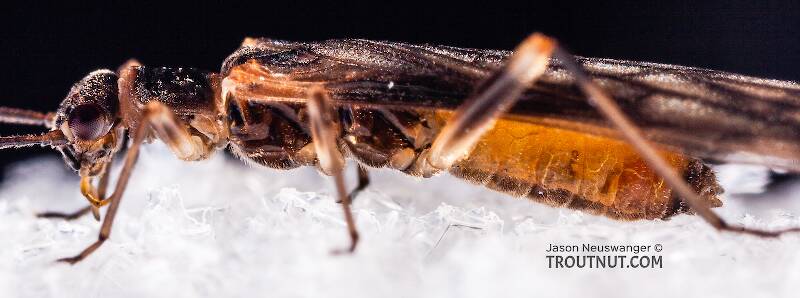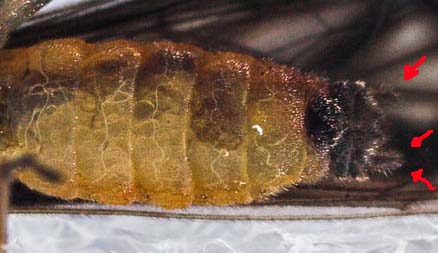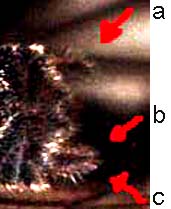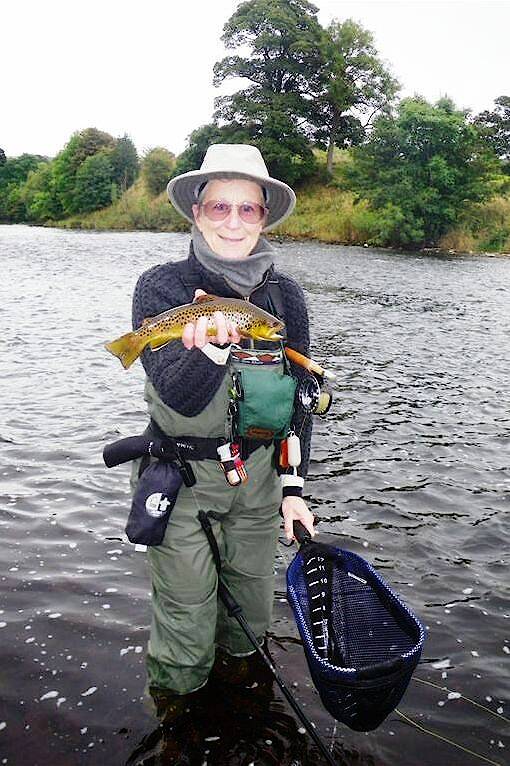
Salmonflies
Pteronarcys californica
The giant Salmonflies of the Western mountains are legendary for their proclivity to elicit consistent dry-fly action and ferocious strikes.
Featured on the forum

Nymphs of this species were fairly common in late-winter kick net samples from the upper Yakima River. Although I could not find a key to species of Zapada nymphs, a revision of the Nemouridae family by Baumann (1975) includes the following helpful sentence: "2 cervical gills on each side of midline, 1 arising inside and 1 outside of lateral cervical sclerites, usually single and elongate, sometimes constricted but with 3 or 4 branches arising beyond gill base in Zapada cinctipes." This specimen clearly has the branches and is within the range of that species.

Troutnut is a project started in 2003 by salmonid ecologist Jason "Troutnut" Neuswanger to help anglers and
fly tyers unabashedly embrace the entomological side of the sport. Learn more about Troutnut or
support the project for an enhanced experience here.

A few of these tiny stoneflies were among the only species of aquatic insect adults in the air on this particular afternoon, with most of the action coming from a species of Epeorus mayfly. I somehow forgot to photograph this one on the usual ruler, but I recall it was very, very small, with an abdomen no more than 1mm in girth and the body, not counting the wings, probably just 5-7mm long.
JaneBug
Posts: 1
Posts: 1
JaneBug on Jan 25, 2007January 25th, 2007, 1:36 pm EST
The stonefly in this series of photos is not a Capniidae. It is a Nemouridae, a female Amphinemura. The yellow abdomen has eggs inside. Message from a stonefly researcher from Pennsylvania.
Troutnut on Jan 25, 2007January 25th, 2007, 3:33 pm EST
Thanks! I've switched her over to that genus.
Jason Neuswanger, Ph.D.
Troutnut and salmonid ecologist
Troutnut and salmonid ecologist
Taxon on Jan 26, 2007January 26th, 2007, 2:34 am EST
JaneBug-
Perhaps you could educate me a bit concerning female adult stonefly anatomy. What are those abdominal appendages (pointed to by red arrows) called in my blowup of Jason's ventral photo?

In case JaneBug is not still monitoring this thread, if anyone else knows the answer to my question, please enlighten me. Thanx.
Perhaps you could educate me a bit concerning female adult stonefly anatomy. What are those abdominal appendages (pointed to by red arrows) called in my blowup of Jason's ventral photo?

In case JaneBug is not still monitoring this thread, if anyone else knows the answer to my question, please enlighten me. Thanx.
Taxon on Jan 27, 2007January 27th, 2007, 5:21 pm EST
David-
Three tails? Seems like one too many.
Three tails? Seems like one too many.
Troutnut on Jan 28, 2007January 28th, 2007, 4:12 am EST
I don't think he's suggesting three tails. The two lower arrows look like they're both pointing to the same bottom tail. What is that middle one supposed to be pointing at?
Jason Neuswanger, Ph.D.
Troutnut and salmonid ecologist
Troutnut and salmonid ecologist
Taxon on Jan 28, 2007January 28th, 2007, 5:03 am EST
Jason-
Is the lower tail bent back on itself or something? If so, the middle arrow is pointing at the bent back section. Otherwise, there would appear to be a second appendage just above the lower tail, at which the middle arrow is pointing.
Is the lower tail bent back on itself or something? If so, the middle arrow is pointing at the bent back section. Otherwise, there would appear to be a second appendage just above the lower tail, at which the middle arrow is pointing.
Troutnut on Jan 28, 2007January 28th, 2007, 7:03 am EST
Hmm... if I look at it just right, the wing vein pattern in the background kinda forms a shape that could be mistaken for an abdominal appendage. Is that what you're looking at?
I'm really just seeing the two obvious symmetrical structures, top and bottom. It's very possible that you have a monitor that really brings out the contrast in that picture and makes something else look like part of the abdomen. (I can kind of see something if I tilt my laptop LCD just right, but I think it's nothing.)
I'm really just seeing the two obvious symmetrical structures, top and bottom. It's very possible that you have a monitor that really brings out the contrast in that picture and makes something else look like part of the abdomen. (I can kind of see something if I tilt my laptop LCD just right, but I think it's nothing.)
Jason Neuswanger, Ph.D.
Troutnut and salmonid ecologist
Troutnut and salmonid ecologist
Taxon on Jan 28, 2007January 28th, 2007, 9:54 am EST
Jason-

Hopefully, this will help. I've blown it up about 50%, turned up the contrast significantly, and labeled the arrows. I'm talking about the appendage, labeled b, which comes straight out of the abdomen, as compared to the appendage labeled c, which comes out at a slightly upward angle as compared to the (imaginary) horizon.
Can you see it better now?

Hopefully, this will help. I've blown it up about 50%, turned up the contrast significantly, and labeled the arrows. I'm talking about the appendage, labeled b, which comes straight out of the abdomen, as compared to the appendage labeled c, which comes out at a slightly upward angle as compared to the (imaginary) horizon.
Can you see it better now?
Troutnut on Jan 28, 2007January 28th, 2007, 11:49 am EST
I think what you've labeled appendage C is not an appendage, but a shadow or vein on the wings in the background. A and B are matching appendages on either side of the abdomen, and C is an illusion. I think.
Jason Neuswanger, Ph.D.
Troutnut and salmonid ecologist
Troutnut and salmonid ecologist
CaseyP on Jan 28, 2007January 28th, 2007, 1:15 pm EST
on my monitor, imagine a dumbbell on end. a shows the top bell and b and c show the bottom bell. what's hard to see is the bottom of the rounded shape of the top cerci.
i think...
i think...
"You can observe a lot by watching." Yogi Berra
Quick Reply
Related Discussions
Topic
Replies
Last Reply
12
Apr 21, 2018
by Martinlf
by Martinlf




